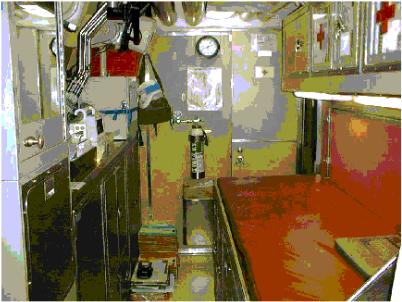Submarine Operational Medicine |
|
Submarines are among the most clandestine platforms in the United States arsenal, and thus have an important role in both conventional and Special Operations. Understanding the capabilities and limitations of submarines can aid embarked personnel in their medical planning for submarine-based operations. There are two basic types of submarines in the United States Navy.
The modern nuclear powered submarine is a veritable mini-city under the sea. The propulsion plant is driven by a nuclear reactor, which eliminates the need to refuel on a regular basis. The amount of food that can be brought onboard is usually the limiting factor in the duration of a given mission. The submarine also makes its own potable water by distillation, and the atmosphere is closely monitored and regulated by equipment that adds submarine-produced oxygen and removes carbon dioxide, carbon monoxide, and other impurities. The partial pressure of oxygen is maintained slightly below atmospheric to decrease the risk of a fire onboard Life onboard a submarine is different from that of any other vessel. Space is obviously at a premium and is a critical limiting factor with respect to equipment and gear brought on by embarked personnel. Mission support equipment will have to be carefully coordinated with the submarine. Based on space limitations, it is common for embarked personnel other than the crew to sleep in temporary bunks in the torpedo room. Below is a space comparison between the medical “sick-bay” area on a modern fast attack and a Ohio class ballistic missile submarine. With these obvious space limitations, especially those on the fast attack, it is easy to understand why a large amount of medical gear is stored in a variety of spaces throughout the submarine. Normally, a Submarine Independent Duty Corpsmen provides the medical care for the entire crew of the submarine. Similar to Special Operations medics and corpsmen, the Submarine Independent Duty Corpsman operates in relative isolation with limited resources and equipment. To qualify to become a Submarine IDC, one must complete an intensive yearlong course that is similar to other Independent Duty Corpsmen courses, but with some important differences. Besides training in medical diagnosis and treatment, management of medical and surgical emergencies, occupational/environmental preventive medicine, laboratory techniques, health physics, and mathematics, Submarine IDC’s also receive instruction in radiobiology, radiation health, nuclear weapons, atmosphere control, and basic submarine skills. Submarines are equipped with an extensive amount of medical, dental, and surgical equipment, as well as an extensive library of texts to aid the Submarine IDC’s in their duties. |
|
Bureau of Medicine and
Surgery |
Operational
Medicine |
United States Special Operations Command 7701 Tampa Point Blvd. MacDill AFB, Florida 33621-5323 |
Home · Military Medicine · Sick Call · Basic Exams · Medical Procedures · Lab and X-ray · The Pharmacy · The Library · Equipment · Patient Transport · Medical Force Protection · Operational Safety · Operational Settings · Special Operations · Humanitarian Missions · Instructions/Orders · Other Agencies · Video Gallery · Phone Consultation · Forms · Web Links · Acknowledgements · Help · Feedback ·
This web version is brought to you by The Brookside Associates Medical Education Division · Other Brookside Products · Contact Us



